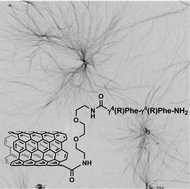Self-assembly of diphenylalanine backbone homologues and their combination with functionalized carbon nanotubes†
Abstract
The integration of carbon nanotubes (CNTs) into organized nanostructures is of great interest for applications in materials science and biomedicine. In this work we studied the self-assembly of β and γ homologues of diphenylalanine peptides under different solvent and pH conditions. We aimed to investigate the role of peptide backbone in tuning the formation of different types of nanostructures alone or in combination with carbon nanotubes. In spite of having the same side chain, β and γ peptides formed distinctively different nanofibers, a clear indication of the role played by the backbone homologation on the self-assembly. The variation of the pH allowed to transform the nanofibers into spherical structures. Moreover, the co-assembly of β and γ peptides with carbon nanotubes covalently functionalized with the same peptide generated unique dendritic assemblies. This comparative study on self-assembly using diphenylalanine backbone homologues and of the co-assembly with CNT covalent conjugates is the first example exploring the capacity of β and γ peptides to adopt precise nanostructures, particularly in combination with carbon nanotubes. The dendritic organization obtained by mixing carbon nanotubes and peptides might find interesting applications in tissue engineering and neuronal interfacing.


 Please wait while we load your content...
Please wait while we load your content...